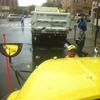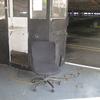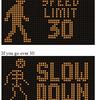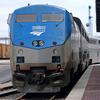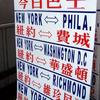Jim O'Grady appears in the following:
As New York City's Job Rate Rises, So Does Subway Ridership
Friday, May 27, 2011
(Photo by AZY_NYC / Flickr Creative Commons)
(New York, NY - Jim O'Grady, WNYC) Even though the New York Metropolitan Transportation Authority raised subway fares three times in the past three years, subway ridership is on the rise. That may be a sign of an improving economy.
New Yorkers experienced a 17 percent fare hike last December, one of the biggest ever. But except for a slight dip during the January blizzards, subway ridership has risen every month since, according to data given to Transportation Nation by the New York MTA.
The authority says subway ridership tracks employment -- when the job rate goes up, so does the number of straphangers.
In 2008, after a nearly seven percent fare increase, subway ridership went up nine months in a row. The opposite happened in 2009, when the recession moved transit use in one direction: downward.
Unlike the subway, New York's buses have seen dwindling numbers of riders in recent years. And after the largest bus route cuts in a generation last June, even fewer city residents have been taking the bus.
The ability of straphangers to absorb yet another fare hike will be tested next year, when the New York MTA is set to raise fares again by 13 percent.
New Fuel Economy Stickers Could Change Buying Habits
Wednesday, May 25, 2011
 (New York, NY- Jim O'Grady, WNYC) The EPA says it will require car makers to put labels on new vehicles showing consumers how much they'll spend in a year on fuel. And how much they'll pollute.
(New York, NY- Jim O'Grady, WNYC) The EPA says it will require car makers to put labels on new vehicles showing consumers how much they'll spend in a year on fuel. And how much they'll pollute.
The new labels reflect federal fuel standards passed last year that require better gas mileage in cars and trucks. Part of what the labels will show is how much money a buyer will save in fuel costs over five years compared to an average car under the old fuel standard--and how much more money they'll save if the car is electric.
The labels will also rate a vehicle on a one-to-ten scale for smog and greenhouse emissions. Student Rob Renz stopped by an EPA news conference in Lower Manhattan to inspect one of the new labels.
"I'm into cars," he said. "But I like to know a lot before I buy anything. I'd like to know each and every detail of what I'm about to buy."
He said liked what he saw. Use of the labels by car makers is voluntary until 2013, when they become mandatory.
The Departments of Energy and Transportation decided not to include a letter grade for fuel efficiency on the stickers, a proposal for which, some environmental groups had advocated. Read the full DOT announcement highlighting all the changes here.
And for a visual, you can see the sticker online here. There's a slightly different design depending on whether the car is gas powered, plug-in hybrid, or electric.
![]() Follow Transportation Nation on Twitter.
Follow Transportation Nation on Twitter.
New York MTA's Website Promises More Timetables, Transit Apps
Wednesday, May 25, 2011
 (New York, NY -- Jim O'Grady, WNYC) The NY Metropolitan Transportation Authority's website just got a makeover. It now sports a simplified design and better tools for planning trips and saving money on fares.
(New York, NY -- Jim O'Grady, WNYC) The NY Metropolitan Transportation Authority's website just got a makeover. It now sports a simplified design and better tools for planning trips and saving money on fares.
The new homepage lets riders find out if delays are expected at a particular time in the future because of construction work, while the old site only let people check the current status. And the "service status" function--which gives updates on everything from closures on bridges to escalator breakdowns--can now be installed as a widget on other websites.
The site famously failed last January when some 500,000 users at once tried to access the site during a 19-inch snowstorm. Users were given a plain text version of the site. The MTA said at the time it was a victim of its own success, and had attracted more users than it can handle.
The MTA site also features 36 mobile apps by independent companies that do things like help riders pick the subway car that will get them closest to their exit and compile travel alerts and advisories.
Riders can use the site's "Ways to Save" box to find out whether they qualify for reduced fares.
What do you think?
![]() Follow Transportation Nation on Twitter.
Follow Transportation Nation on Twitter.
Yankees Parking Garage Facing Failure
Tuesday, May 24, 2011
WNYC transportation reporter Jim O'Grady discusses his reporting on the barely used Yankees parking garage which is facing financial collapse after receiving lots of public subsidies.
Truck Safety Mirror Measure Passes NY Senate
Monday, May 23, 2011

The New York State Senate passed a bill Monday that would require special safety mirrors on the hoods of some trucks that use city streets.
Truck Safety Mirror Measure Passes NY State Senate
Monday, May 23, 2011
A crossover mirror on the hood of a city sanitation truck, as viewed from the driver's seat. (Photo by: Jim O'Grady.)
(New York, NY - Jim O'Grady, WNYC) The New York State Senate passed a bill today that would require special safety mirrors on the hoods of some trucks that use city streets.
The so-called crossover mirrors attach to both sides of the hood and allow drivers to spot pedestrians ordinarily hidden by the front of the truck. On Friday, Mayor Bloomberg announced his support for the bill at a street corner press conference in Bay Ridge, Brooklyn, where a woman and her daughter were struck and killed by a van in 1994.
"The mirrors cost on average about a hundred bucks," Bloomberg said. "And when you compare to what it costs for a full tank of gas for these trucks, about 400 dollars, you'll see that it is not prohibitively expensive and it really is a great investment for our safety."
The bill would apply to New York State trucking companies that send vehicles into the five boroughs. Trucks used by city agencies already use the mirrors.
Kendra Adams, president of The New York State Motor Truck Association said a better solution would be installing mirrors at intersections to give all drivers a better view of pedestrians. "Trucks account for only four percent of curbside injuries in the city," she said. "We support and practice safety."
The bill now moves to the New York State Assembly.
After Hundreds of Millions of Dollars of Public Subsidies, Barely Used Yankees Parking Garages Face Financial Collapse
Thursday, May 19, 2011
This garage was built on a park in the Bronx at behest of the Yankees. Two-thirds empty on game days, the garage is now facing financial collapse
(Bronx, NY - Jim O'Grady, WNYC) In the far North Bronx, near the Yonkers border, right fielder Stephan Alamies of the All Hallows High School varsity baseball team is batting against Mount Saint Michael. This is a home game for All Hallows--but they’re playing on their opponents’ field. They drove 45 minutes by bus to get here. Coach Edgardo Guttierez says the team used to play four blocks from school.
“Unfortunately, the Yankees built their parking lot on the field that we used to practice on," he said.
On the team bus, the players weren't any happier than their coach. "We feel like a bunch of gypsies just traveling all over the place," said Alamies before the other players chimed in: “It’s depressing.” “People want to come see us but they can’t see us. We don’t have a home field, we don’t know where we’re at.”
The team, like the rest of the neighborhood around Yankee Stadium, is still waiting for promised replacement fields.
![]() Follow Transportation Nation on Twitter.
Follow Transportation Nation on Twitter.
But so few Yankee fans are parking at eleven garages and lots around the new stadium that the company managing them may soon default on $237 million in tax exempt bonds used to build them. In an effort to stave off collapse, the garages recently hiked prices to $35 a game. But as of last month, they were two thirds empty on game days.
According to public documents and two separate analyses, the Bronx Parking Development company owes the city $17 million in back rent and other payments. The city is paying $195 million to replace the parkland it gave to the Yankees. And New York State spent $70 million to build Parking Garage B. That's where Derek Jeter and his fellow players park, along with VIP ticket holders. The garage is not open to the public, and allows those who use it to enter directly into the stadium.
Bettina Damiani is project director at Good Jobs New York, a government watchdog group. "It doesn't seem to make sense to publicly subsidize the stadium and also publicly subsidize the parking garages," she said, adding it isn’t just about the money. "This is about the impact it's had on an entire generation of kids who have not had access to open public park space the way they did have."
The new Yankee Stadium is smaller than the old one. But when the team insisted in 2006 that it needed 2,000 extra parking spots, the New York City Industrial Development Agency issued 237 million dollars in tax exempt bonds for an expanded parking system--paving over the neighborhood's only regulation baseball diamonds to do it.
The Yankees insisted from the beginning that they needed 9,000 parking spots, 2,000 more than before. They even made it a legal condition for not moving out of the Bronx.
At a City Council hearing in 2006, Yankees president Randy Levine predicted additional parking garages would bring less traffic to the neighborhood. “By building the new parking spots, the cars will get out of the community, won’t circle around the community and disrupt it, and will go into parking lots," he said. As a sweetener, the Bloomberg administration, pushing the plan, added a last-minute concession: it would build a new Metro-North stop next to the field.
The Yankees got their new stadium -- and their 9000 parking spots. The stadium plan passed the city council, 44 to 3.
In 2006, Speaker Christine Quinn defended the garages.
“I think it would be great if people could go to sporting events exclusively on mass transit but that’s not going to happen," she said. "So one has to, when they’re developing projects like this, have a reality sense of what the needs are as it relates to parking."
But the MTA tells WNYC that more than 50% of a typical sell-out crowd arrives by train, bus or ferry. Many fans who do drive skip the $35 dollar charge for a spot at a Yankee garage and either park on the street or at cheaper lots in the neighborhood. One local garage advertises on a flyer that says, "Don't pay 35 dollars." Its prices start at $15.
Little has changed from 2006 outside the stadium on game days. Traffic cops stand on corners directing the circling cars. By first pitch, every one of the area’s 3,200 curbside spots is filled.
Angel Castillo, a car-owner who lives four blocks from the stadium, sees it all season. “Oh my God, sometimes if I come and the game starts, I gotta wait when the game finished one hour after the game," he said. "After midnight.”
Castillo says street parking is so scarce during Yankee homestands that he’ll leave his car in a spot for four days and pay fifteen dollars each way for a car service to his job as a barbershop manager in the North Bronx.
Mayor Bloomberg says private bondholders, not taxpayers, will be on the hook if the Bronx Parking Development Company defaults on the bonds. On his weekly radio show, he shrugged off the Bronx Parking Development Company's possible collapse.
“The city has no downside," he said. "If they were to go bankrupt, it doesn't hurt us. It wouldn’t be good for the project."
But taxpayers have been hurt.
Back at the game in the North Bronx, Stephan Alamies waits for the pitch. It’s 3-3 in the bottom of the 10th inning. He swings…and the ball is gone. All Hallows wins on a walk-off homer. The victory helps them clinch their division. Today, they’re preparing for the playoffs.
Yankees Parking Garages Driven to Brink of Financial Collapse
Thursday, May 19, 2011

So few Yankee fans are parking at 11 garages and lots around the new stadium in the Bronx that the company managing them may soon default on $237 million in tax-exempt bonds used to build them.
Drivers Who Speed Will See Skeletons
Thursday, May 12, 2011

NYC Drivers Who Speed Will See Skeletons
Thursday, May 12, 2011
On some streets in NYC, drivers breaking the speed limit will see a skeletal warning on a roadside digital sign.
(New York, NY - Jim O'Grady, WNYC) New York City is warning drivers that speeding could mean death.
Drivers who exceed the speed limit in two city neighborhoods will soon see the words "SLOW DOWN" and the image of a skeleton flashed on electronic signs by the side of the road. As long as a driver obeys the city's 30 mph speed limit, no skeleton will appear.
The signs have been placed along stretches of Bruckner Boulevard in the Bronx and Richmond Avenue in Staten Island – roads that, respectively, were shown by a DOT study to have 96 percent and 66 percent of motorists speeding.
"We're playing with people's lives," Bloomberg said of speeding vehicles. He then cited global statistics on traffic fatalities: "About 148 people die in road traffic deaths every single hour. I think it's 1.3 million people a year. This is going to be the fifth largest killer in the world in another few years."
City Department of Transportation Commissioner Janette Sadik-Khan joined Bloomberg at the press conference, which took place at the intersection of Broadway and Fifth Avenue in Manhattan — a spot that had once been a traffic lane but is now a protected pedestrian island.
She said the department will test a new slow-speed driving zone in the Claremont section of the Bronx, which has a high concentration of schools and vehicle crashes per square mile. The largely residential neighborhood will get a 20 mile per hour speed limit this summer — the lowest in the city.
Sadik-Khan said driving only 10 miles per hour above the city's 30 miles per hour speed limit can mean the difference between life and death: "If a pedestrian is hit by a car going 40 miles per hour, there's a 70 percent chance that pedestrian is going to die," she said. "If a pedestrian is hit by a car at 30 miles per hour, there's an 80 percent chance that pedestrian will live."
Bloomberg said if the slow-speed zone and the skeleton signs prove effective, more will be set up in other neighborhoods in the city.
Northeast Rail Reaps Nearly $800 Million Windfall From Fed Funds Returned by Florida -- But Will Trains Be High Speed?
Monday, May 09, 2011
(Photo by StevenM_61 / Flickr - creative commons)
(New York, NY - Jim O'Grady, WNYC) U.S. Transportation Secretary Ray LaHood came to Penn Station to announce he was giving $795 million to improve rail service in the Northeast. LaHood's largesse is part of a $2 billion award going to rail projects in 15 states-- money that became available after Florida governor Rick Scott canceled rail plans there in February.
But that doesn't mean riders can expect a bullet train to Boston any time soon.
LaHood said northeast corridor train speeds will increase from 135 to 160 miles per hour--but only along open stretches in Pennsylvania and New Jersey, where Amtrak already moves swiftly. Bottlenecks like hundred year-old bridges and tunnels will continue to slow trains in other parts of the corridor.
The $795 million will fix some, but not all, of those problems. Officials couldn't say how much time might be shaved from popular routes. One transportation expert thought saving 15 minutes between New York City and Washington, DC, was probably the best that could be hoped for from the upcoming round of upgrades. Supporters say Amtrak should greatly increase its reliability, which in itself will save thousands of rider hours.
Petra Todorovich, spokeswoman for the Regional Plan Association, said it would take a $100 billion investment to bring European-style high speed rail to the northeast. She said today's DOT grant will bring long-awaited improvements to the region's rail infrastructure, lifting it to something approaching a state of good repair.
Todorovich said it was about time the federal government spent money on the most heavily trafficked rail corridor in the country, with 250 million passengers per year.
"We were disappointed that the previous grants ignored the northeast corridor," she said. "The previous funding all went to areas that don’t have a market yet. We feel very gratified that that the federal government is directing funding where people rely on rail the most. Even if it doesn’t result in a bullet train overnight, it will result in increased speed and reliability where people use rail the most."
The Brookings Institution's Robert Puentes added: "Concentrating the relocated funding in the Northeast Corridor, California, and parts of the Midwest is a happy byproduct of a difficult process but it is probably where the high speed rail funding should have been concentrated in the first place."
New York Governor Andrew Cuomo also praised the grant. In a statement, he recalled it's not the first time the state has benefited from Republican governors turning down rail money. "In 2010, Wisconsin and Ohio returned their federal funding," Cuomo said. "Of that money, New York received $7.3 million."
Northeast Rail Reaps Nearly $800M From Fed Funds Rejected by Florida
Monday, May 09, 2011

The government has awarded $795 million to improve rail service in the Northeast — the biggest portion of the $2.2 billion doled out by the Obama administration to states after it was rejected by Florida's governor.
In Wake of Bronx Crash, New Fed Rules For Long Distance Buses
Thursday, May 05, 2011
(photo by Naomi A. / Flickr creative commons)
(New York, NY - Jim O'Grady, WNYC) Almost two months after fifteen people were killed in a bus crash in the Bronx, federal regulators have announced new safety rules for long distance buses. The rules increase oversight mainly on drivers and new bus companies.
U.S. Department of Transportation Secretary Ray LaHood says new bus lines will have to undergo safety audits before they can sell their first ticket. And bus drivers could lose their commercial licenses if they violate drug and alcohol laws even while operating their own private car.
The rules were embraced by American Bus Association president Peter Pantuso, who joined LaHood at a press conference in Washington, DC. The association represents existing carriers, who wouldn't be subject to the safety audits. And the toughest of the new rules are aimed at drivers, like the creation of a national database tracking the results of drivers' alcohol and drug tests.
Whether the rule change about driving under the influence would have prevented the bus crash in the Bronx is doubtful. That driver had been stopped in his private car--but for speeding, not DUI. And he kept the summonses from affecting his commercial license by allegedly giving a false name to police.
Bus companies and state transportation agencies will have three years to prepare to comply with the new safety rules.
In Wake of Deadly Bronx Crash, New Fed Rules For Long-Distance Buses
Thursday, May 05, 2011

Nearly two months after 15 people were killed in a bus crash in the Bronx, federal regulators have announced new safety rules for long-distance buses that increase oversight on drivers and new bus companies.
NYC Advocacy Group: Subways Are Dirtier. MTA Disagrees.
Thursday, May 05, 2011
(New York, NY - Jim O'Grady, WNYC) New York's subway cars are getting dirtier, according to a transit riders advocacy group.
The latest Shmutz Survey conducted by the Straphangers Campaign found only 47 percent of subway cars were clean when researchers rode the trains over two months last fall compared with 51 percent the year before. (Schmutz is a Yiddish word for icky dirt and is part of the lingua franca in New York City.)
The New York Metropolitan Transportation Authority, which runs the subway, is fighting back much more aggressively than it has in previous years: it disputes the findings and questions the report's methodology.
City's Subways Are Getting Filthier, Says Advocacy Group
Thursday, May 05, 2011

The city's subway are getting dirtier, according to a straphangers' advocacy group.
NYC Dept of Transportation Says Biking Is Up And Streets Are Safer
Monday, May 02, 2011
(New York, NY - Jim O'Grady, WNYC) Biking continues to go up in New York as driving and transit ridership stays nearly flat, according to a report being released today by the New York City Department of Transportation. The report found that bicycle commuting into Manhattan increased by 13 percent in 2010. During that same period, subway and bus ridership dropped by a little bit over 2 percent, while car traffic rose slightly.
Source: NYC Dept of Transportation
Source: NYC Dept of Transportation
The report, the department's third annual Sustainable Streets Index, showed other biking trends pointed upward. Commuting by bike in New York City is up 262% in the past ten years, and bicyclists now make up a third of the evening rush hour traffic along major bike routes in Brooklyn and Manhattan. On top of that, more than half a million adult New Yorkers ride bicycles at least several times a month.
The report comes after several other reports, including reports out of NYU and Rutgers, say cycling is only a small percentage of commuters. But the NYC DOT says that is based on older data gathered by the US census, and that census data is an inexact measure of bike commuting because it only measures "primary" methods of commutes. The DOT says its methods are more accurate because they measure actual bicycle riders, consistent with national traffic management measures.
Department of Transportation commissioner Janette Sadik-Khan said a big part of that growth came from cyclists using bike lanes. "I think if you build it they will come," she said about lanes. "They'll come if you build a safe, effective network that connects neighborhoods where people want to bike."
Critics say bike lanes take up too much road space and makes it harder for cars to navigate the city. But the report says in addition to bike lanes, expect the installation of traffic-calming features like pedestrian malls, street-narrowing, and removing through-lanes for turning bays. Sadik-Kahn said all of those changes have reduced deaths and injuries from crashes.
Other findings:
Traffic speeds in Midtown Manhattan improved by six percent between the fall of 2008 and the fall of 2009, and then leveled off in 2010.
Ridership on crosstown buses dropped 5 percent--except on 34th Street, which has dedicated lanes and countdown clocks.
January is the fastest month for overall traffic speed in New York. December is the slowest.
After the city began a pilot program that allowed businesses to take late-hour and early morning deliveries, delivery companies saw vehicle travel times improve 130% compared to evening and midday travel speeds. Sadik-Khan said the program will be made permanent and expanded.
New parking meters in Park Slope that raise prices during times of high demand reduced parking duration by 20 percent, enabling more drivers to find metered spaces and reducing overall traffic volumes on the neighborhood's main commercial avenues.
Follow Transportation Nation on Twitter.
Horse Players Train To The Track Again In NY
Friday, April 29, 2011
 (New York, NY - Jim O'Grady, WNYC) As of today, thoroughbred racing fans in New York resumed riding the Long Island Railroad to Belmont Raceway, a storied track just east of the borough of Queens.
(New York, NY - Jim O'Grady, WNYC) As of today, thoroughbred racing fans in New York resumed riding the Long Island Railroad to Belmont Raceway, a storied track just east of the borough of Queens.
The New York MTA cut the service last year--except for one day in June--to help close a gap in its budget. That one day was the Belmont Stakes, the third leg of the Triple Crown, when tens of thousands flock to the track. Other than that, horse players were left to drive or take the bus.
But then the New York State Racing Association came into a windfall, which it is drawing on to pay for the restored train service.
The shift in the association's fortunes began when New York State shuttered its dozens of Off-Track Betting parlors in December. As a result, attendance at Aqueduct Racetrack, another local venue for thoroughbred racing, jumped by 50 percent — and the handle, or total amount bet on the races, was up 70 percent.
New York Racing Association spokesman Dan Silver said that has been good for the bottom line of his company, which gets 10 percent of all wagers made at the track — more than the 3 percent it was getting from bets made at Off-Track Betting.
Silver said he's expecting a similar surge in attendance at Belmont Raceway during the upcoming spring and summer season.
That's why the association stepped up last week and agreed to pay the $150,000 it will cost to restore Long Island Railroad service to the track. Silver said the investment is worth it to get more customers. Spectators who take the train to Belmont this weekend are getting free admission to the grandstand.
![]() Follow Transportation Nation on Twitter.
Follow Transportation Nation on Twitter.
Biking on the Rise in the City, DOT Says
Friday, April 29, 2011

The number of those biking in the city is increasing while those taking mass transit or driving has nearly leveled off, a new report found.
The findings, part of the Sustainable Streets Index report by the city Department of Transportation, found bicycle commuting into Manhattan increased by 13 percent in 2010. During that same period, subway and bus ridership dropped by a little more than 2 percent, and car traffic rose slightly.
Report Finds Over Half of NYC Parking Placards Surveyed Are Either Bogus or Used Improperly
Wednesday, April 27, 2011
(New York, NY - Jim O'Grady, WNYC) Despite the Bloomberg administration's 2008 crackdown on counterfeit and improperly used parking placards, a new report say the city's system of issuing and overseeing the permits "remains broken."
Transportation Alternatives, an advocacy group, found 57 percent of placards examined on the dashboards of vehicles in five New York business districts were either legal placards used illegally, or outright fakes. The rate of bogus placards is 95 percent in the courthouse area of Lower Manhattan, the report says, where only 11 of 244 placards surveyed were being properly used.
![]() Follow Transportation Nation on Twitter.
Follow Transportation Nation on Twitter.
The report's authors claim one in four of the 1,450 permits examined was a fake. They go on to extrapolate from the city's current claim of 78,000 legal placards that anywhere from 10,000 to 25,000 fraudulent placards are now in use by drivers. To give scale to those numbers, there are 12,000 yellow cabs in New York. The report says placard abuse in the courthouse area has actually increased since the group last studied the issue in 2007.
In 2008, Mayor Bloomberg directed every city agency to reduce its parking placards by 20 percent. He also centralized the issuance of placards to the New York Police Department and Department of Transportation. The city's best guess at the time was there were 150,000 to 170,000 parking permits in use--and those were just the legal ones.
"Parking placards are a necessary tool for conducting City business, but we have no tolerance for their abuse, which contributes to congestion," said Mayor Bloomberg at the time. "We will give out placards only to those who need to use them to further the public interest."
Apparently, that is a goal only partly realized. Transportation Alternatives researchers, who canvassed five busy neighborhoods in January, say they found a stubborn pattern of abuse. Bogus placards included official-looking permits unrecognized by the city, photocopies of real permits, expired permits and personal effects used as permits: transit vests, patrol manuals and even a sheet of paper scrawled with the letters "NYPD." Drivers typically used the bogus placards to double-park or leave their vehicles on sidewalks or in bike or bus lanes.
The report says the entire placard system once again needs an overhaul: "Each step in the process—from creation of the permits, to distribution and enforcement—is fatally flawed, creating a system wrought with abuse and lacking effective oversight."
Mayoral spokesman Stu Loeser disagreed. He said the city has cut the number of placards in half and works hard at enforcement. "Working with the Internal Affairs Bureau, the NYPD regularly tows cars using placards inappropriately," he said in and email. "In terms of fake placards, they get ticketed."
And city officials added that since the NYPD established its special Internal Affairs Bureau Placard enforcement program in April 2008, it has issued 28,000 summonses, towed 6,000 vehicles, and arrested 32 people for unauthorized use or duplication of official placards.
Transportation Alternatives says the best way to insure proper use of the placards would be to stamp each one with a bar code that could be scanned by traffic enforcement agents.
Read TA's Parking Placard Report.

